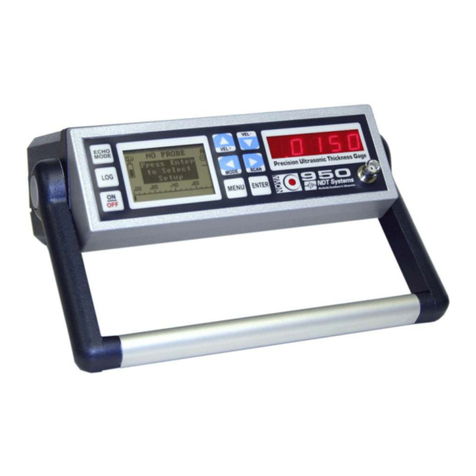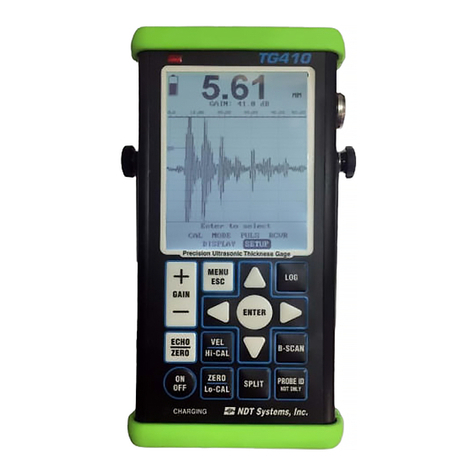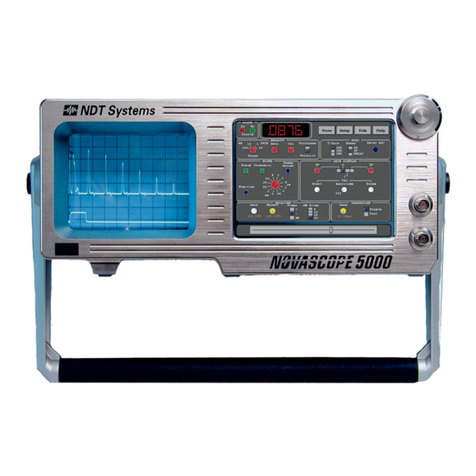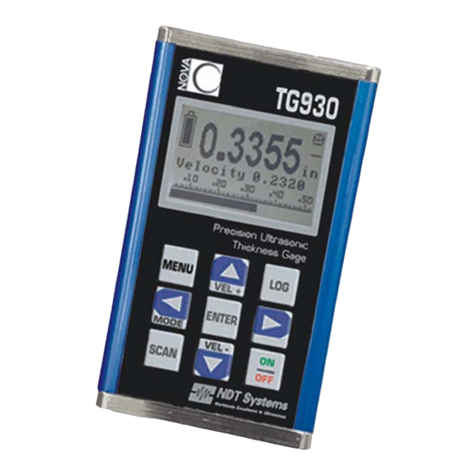TG110DL User’s Manual
9 | P a g e NDT Systems, Inc. 5542 Buckingham Drive, Huntington Beach, CA 92649, PH: 714-893-2438
Backlight: The backlight has three settings: AUTO, OFF, and ON. AUTO: the backlight will turn on automatically
when the transducer is coupled with the part under test, or when a button on the keypad is pressed. The backlight
will turn off automatically after approximately 5 seconds. OFF: The backlight will stay off indefinitely. ON: The
backlight will remain on continuously as long as the instrument is powered on.
NOTE: If the gauge is being used in an area with high ambient light, the backlight may not be needed. With the
backlight turned off battery life will be increased significantly. As it becomes more difficult to see the display in
darkened conditions, the backlight can be turned to the AUTO or ON settings.
Contrast: Scrolling the contrast value down will darken the display and scrolling the contrast value up will lighten
the display.
Units: Allows the operator to select the measurement units in inches (in) or millimeters (mm).
SELECT PROBE: From the Menu screen, move the cursor down to SELECT PROBE
and press the ENTER button to access the transducer selection menu. A list of
transducer part numbers will appear, allowing the user to select current probe.
The default probe is AUTO, which utilizes NDT Systems' patented automatic
probe recognition. In this mode the gauge has been set up for optimum
performance with the availa ble line of transducers specifically designed for the
TG110DL. Please see the accessories page for other available transducers.
Also available in the SELECT PROBE menu is a library list of legacy NOVA Series transducers. These transducers
were originally provided with the NDT Systems, Inc Nova 100D which has been available for many years. The items
on this list allow you to use your existing investments in Nova series transducers. In time this list will be increased
to support other transducers as well. These notifications will be available on the NDT Systems web site at
www.NDTSystems.com.
2 POINT CALIBRATION: An additional means of calibrating the TG-110DL to a
specific material. From the Menu screen, move the cursor down to 2 POINT CAL
and press the ENTER button to access the 2-point calibration setup display.
Perform the calibration of the low thickness and high thickness values from this
screen. Accuracies may be impr oved while using this calibration method,
particularly on smaller diameter piping or elbows. You will however, need a
sample material type you wish to measure with at least two known thickness points. To use this mode the user
places the transducer over the minimum thickness value to be measured and uses the right and left arrow buttons
to scroll the “Lo Thick” number to the known minimum thickness value. Scroll down to “Hi Thick” then place the
transducer on upper thickness value and again use the right and left arrow buttons to scroll to that known value.
While coupled to high thickness, press menu to save the calibration and return to the previous menu.
GAIN: From the Menu screen, move the cursor down to GAIN and use the LEFT and RIGHT arrow buttons to switch
between “High” and “Low”. This feature allows the user some flexibility when adjusting to various materials and
surface conditions. The default setting is “High”, but “Low should be used when measuring an extremely
acoustically conductive material like aluminum.































